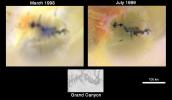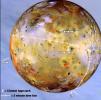A volcano named Zamama on Jupiter's moon Io has recently changed in appearance as seen in this pair of images of Io acquired by NASA's Galileo spacecraft as it approached Io in preparation for a close flyby.
The false color images use the near-infrared, green and violet filters (a range greater than the range the human eye can see) of the spacecraft's camera, processed to slightly enhance Io's naturally vibrant colors. The image on the left was acquired in March 1998 during Galileo's 14th orbit and the image on the right was collected in July 1999 during the 21st orbit. The July 1999 images are the highest resolution images of Io taken by Galileo since it entered orbit around Jupiter in December 1995.
Zamama formed during the time period between the flybys of NASA's Voyager spacecraft in 1979 and Galileo's first images of Io taken in 1996. Based on these images, Galileo scientists suspect that the dark lava is erupting from a crack in the ground. Analysis of combined data from Galileo's camera and its near-infrared mapping spectrometer instrument showed that the lava erupting at Zamama must be hotter than 830 C (1,500 F). Because this too hot to be sulfur, scientists believe the lava may contain silicates.
The most dramatic difference between these two images is that the volcanic plume that was active in March 1998 and earlier had stopped erupting by July 1999. The rising core of the umbrella-shaped plume can be seen in the 1998 image as a bluish spot in the center of the dark lava. Dark and bright spokes of material falling away from the core are also visible. When it falls back to the ground, this material makes circular white and yellow deposits around the vent. The white deposits are thought to be composed mostly of sulfur dioxide that left the volcanic vent as a vapor and condensed into a frost as the gases expanded into the near-vacuum of Io's atmosphere. Interestingly, red plume material has only been deposited to the northwest. This might be the result of small pockets of boiling sulfur that produce droplets of red sulfur blown outward by the main plume. Most of the other, more subtle color variations around Zamama are likely to be the result of different lighting conditions that existed when the two images were taken.
A high-resolution (20 to 40 meters or 66 to 130 feet per picture element) strip of images across Zamama is planned during Galileo's flyby of Io on October 10, 1999. These images will be useful in determining how lava moves on Io's surface, specifically whether the lava travels in open rivers of lava or in well-insulated lava tubes. The size and shape of features on the lava flows can be used to estimate properties of the lava that will provide vital clues to the still unanswered question about what kind of lava is erupting from Io's volcanoes.
North is to the top of the pictures. The images are centered at 17.4 degrees north latitude and 173 degrees west longitude. The image on the left was taken on March 1998 at a range of 294,000 kilometers (183,000 miles) and has a resolution of 3 kilometers (2 miles) per picture element. The Sun illuminates the surface from the right. The image on the right was taken in July 1999 at a distance of about 130,000 kilometers (81,000 miles) and has a resolution of 1.3 kilometers or 0.8 miles per picture element. The Sun illuminates the surface from almost directly behind the spacecraft.
 | Click on this image to view
a context image of Io's
Zamama volcano.
(MRPS95333) |
 | Click on this image to view
Galileo's flight plan for I24 & I25.
(MRPS95336) |
The Jet Propulsion Laboratory, Pasadena, CA, manages the Galileo mission for NASA's Office of Space Science, Washington, DC. JPL is a division of the California Institute of Technology, Pasadena, CA.
This image and other images and data received from Galileo are posted on the World Wide Web, on the Galileo mission home page at http://solarsystem.nasa.gov/galileo/. Background information and educational context for the images can be found at http://www.jpl.nasa.gov/galileo/sepo.

